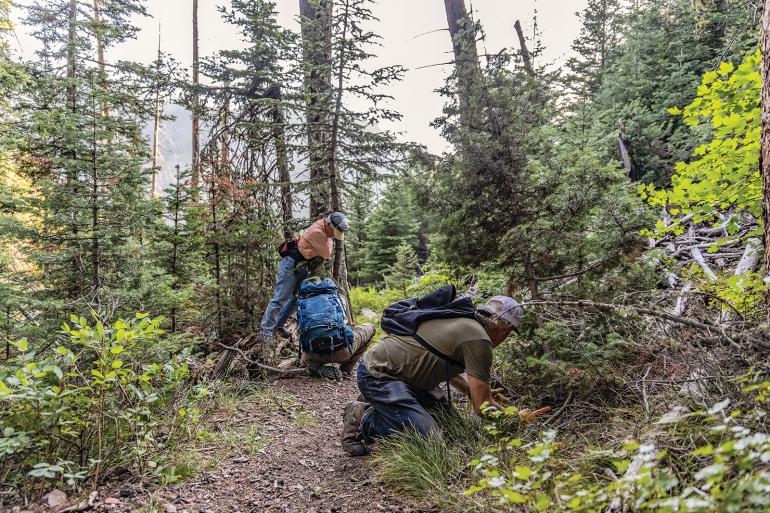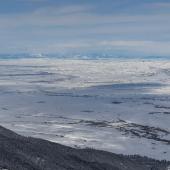Cliff Creek Upkeep
How to stop a trail from falling off the map.
At the southern end of Paradise Valley, a stone’s throw from Yellowstone Park’s northern edge, Cliff Creek flows into the Yellowstone River, ending its short but eventful journey eastbound and down from the Gallatin Crest.
The Cliff Creek Trail runs along its namesake’s mossy banks, climbing through the Hyalite-Porcupine-Buffalo Horn Wilderness Study Area before eventually connecting with the Gallatin Crest Trail. A light smattering of hikers and backcountry horseback riders use the trail, which provides a lovely, moderate adventure where hoof and boot travelers alike can relax and enjoy the beauty and serenity of the forest.
Unfortunately, limited trail use has its downsides. Parts of the trail have fallen into disrepair, becoming overgrown or eroded through the years and making access to the Gallatin Crest from the east a challenge.
While all of us came to the project with different stories and backgrounds—from retirees to students, longtime locals to recent transplants—we all shared the common goals of creating and serving community, spending time on new trails, and encouraging safe access to wild public lands.
For the last few years, a group of volunteers, with the support of the Custer-Gallatin National Forest’s Livingston Ranger District, has been aiming to bring the Cliff Creek Trail back to life.
Since 2018, a volunteer trail crew from Wild Montana’s Bozeman-based Madison-Gallatin Chapter has been conducting twice-annual stewardship projects on Cliff Creek: clearing brush and obstacles like fallen trees and rocks, shoring up eroded areas, and improving the trail’s safety and accessibility. Over the summer, I joined up with the Cliff Creek Trail Adopt-a-Trail crew to see the team’s work for myself and learn just what goes into keeping a trail from falling off the map.
Our main project for the day was rerouting the trail around an eroded section that had collapsed into the creek. While we were digging out the new section, Dustin, one of the crew leaders, explained the key components of building a new trail into a hill: create a solid tread at least two feet wide, build a slight slope in the tread to allow water to drain, and maintain a (roughly) 45-degree angle where the new trail meets the hill to provide stability.
When reconstructing a trail, Dustin says, it’s important to “consider the long-term implications of a particular project or decision,” and take into account the needs of all potential trail users. A narrow path beside a drop-off may be navigable for hikers, but such a route is vulnerable to erosion and could present a real obstacle to bikes or horses. Addressing an issue like this now ensures that the trail remains safe and passable for all recreationists for years to come.
Dustin knows his way around trail stewardship. He’s been involved with this Adopt-a-Trail program for the past three years, after being inspired to volunteer while working on a trail crew in Yellowstone. The best part of volunteering, he says, is sharing his knowledge and experience with others and giving back to the community.
Although the work was physically demanding, the clear fall day, good company, thrill of being out on the trail, and the reward of seeing our progress made for a fun and entertaining outing.
Maintaining public access to public land is, it goes without saying, another giant benefit. No matter who I talked to, they’d bring up the importance of supporting the community. Volunteers spoke both about the happiness they find giving back locally and the pride they feel being meaningful contributors to the conservation and outdoor-recreation community more broadly. While all of us came to the project with different stories and backgrounds—from retirees to students, longtime locals to recent transplants—we all shared the common goals of creating and serving community, spending time on new trails, and encouraging safe access to wild public lands. All the volunteers I spoke with said they plan on volunteering again and continuing to stay involved with the Adopt-a-Trail program.
That’s a good thing, because Cliff Creek isn’t the only trail that the crew is maintaining. They also spend several days per year working on the heavily-used Lava Lake Trail in the Madison Range, and have worked on the Beehive Basin Trail in Big Sky at the Forest Service’s request.
Although the work was physically demanding, the clear fall day, good company, thrill of being out on the trail, and the reward of seeing our progress made for a fun and entertaining outing. This was a sentiment shared by other volunteers, like Katrina, a third-time participant who says she was drawn to volunteering for the chance to meet with like-minded people, explore new areas, and “get projects done that everyone can enjoy.” In the process, Katrina says she’s gained a deeper appreciation of the work it takes to keep trails in good shape, and developed friendships and skills that she can rely on both on and off the trail.
By the end of the workday, what started as an eroded, narrow and barely passable “trail” was transformed, through the efforts of the crew, into a sturdy new route safe for horses and people alike. Since 2018, the Adopt-a-Trail volunteers have restored about two miles of the Cliff Creek Trail, but the work doesn’t stop there. In the future, the crew plans to clear more brush along its entire length, as well as install new preventive measures to control erosion. Seeing the commitment of longtime volunteers and the excitement of those who were new to the project was inspiring, and it gives me confidence that these goals will ultimately be accomplished, allowing folks of all stripes to use and enjoy the Cliff Creek Trail to its full potential.
Lend a Hand
For every banked turn or cut log on a trail, there’s likely a volunteer behind it. This summer, take an active role in maintaining the trails you recreate on with these organizations.—the editors
Southwest Montana Mountain Bike Association
From cutting out trees, to raking pebbles, to complete reroutes of damaged or dangerous trails, SWMMBA volunteers make bike trails better. There are multiple ways to get involved—both at trail-work events, and as a member of the group’s quick-response team. southwestmontanamba.org.
Gallatin Valley Land Trust
GVLT relies on volunteer groups from businesses, organizations, and clubs to keep local trails in tip-top shape. Group trail projects are typically scheduled from May to October, and include projects like gravel resurfacing, weed management, and brush trimming. gvlt.org.
Montana Conservation Corps
For those seeking a team-based, community experience, MCC is good way to get a foot in the door (or on the trail). In addition to trail work, projects include forest-fuels reduction, watershed restoration, and re-vegetation work. Both adult and youth crews are organized annually. mtcorps.org.
Continental Divide Trail Coalition
No trail-work experience is required to help out with these guys, only a willingness to learn. With projects this summer on sections of the CDT near Butte and Helena, there are plenty of opportunities to get involved. continentaldividetrail.org.











